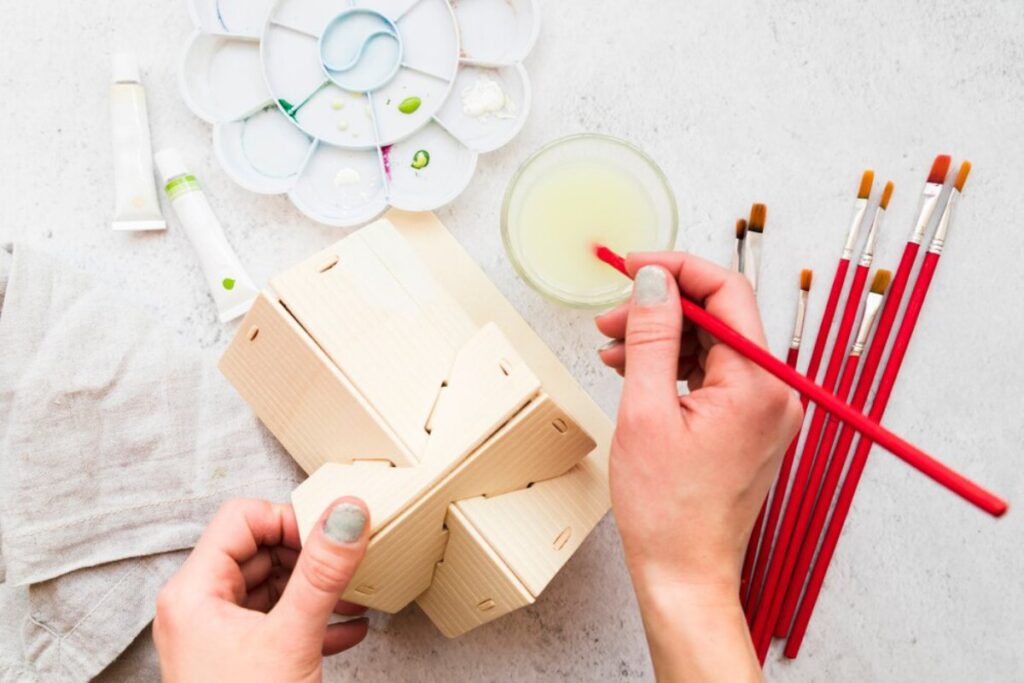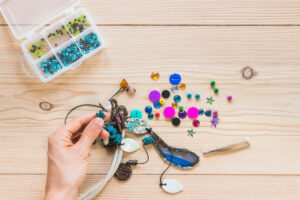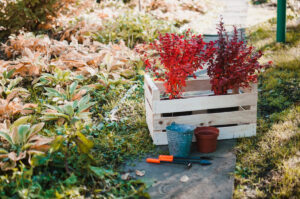The DIY & Crafts Blog

Eco-Friendly Paint Options for Upcycling Projects
Upcycling is the darling of the sustainable living world, and understandably so. Repurposing old materials helps to keep them out of landfills and lessens the demand for newly made products. One crucial step that often gets neglected in this type of creative, eco-friendly project, however, is the paint. Let’s explore eco-friendly paint options for upcycled projects. It takes more than your next green DIY project; it’s just regular paint.
Why Paint Choice Matters in Upcycling
Painting is often the final flourish of any upcycling project. Painting an old dresser or turning glass jars into candle holders is essential. Paint helps with both looks and durability. However, many conventional paints contain harmful chemicals like volatile organic compounds (VOCs), which can release toxins into the air long after application. These substances can be detrimental to both human health and the environment.
Conversely, eco-friendly paints are made using natural ingredients, have low or zero VOC content, and are biodegradable or recyclable. Choosing the correct type of paint aligns your upcycling goals with broader sustainability practices.

Understanding Eco-Friendly Paint
What Makes Paint Eco-Friendly?
To be considered truly eco-friendly, paint must meet several environmental criteria:
- Low or Zero VOCs: VOCs contribute to air pollution and poor indoor air quality.
- Natural or Plant-Based Ingredients include linseed oil, clay, and chalk.
- Non-Toxic Pigments: Derived from minerals rather than synthetic chemicals.
- Biodegradable: It breaks down naturally without harming ecosystems.
- Recyclable Packaging: Often includes containers that can be reused or are made from recycled materials.
Common Types of Eco-Friendly Paints
- Milk Paint: Made from milk protein (casein), lime, and natural pigments. Great for wood and porous surfaces.
- Clay Paint: Natural clay base, breathable and ideal for walls and furniture.
- Chalk Paint: Easy to use, low in VOCs, and provides a matte finish.
- Plant–Based Paint: Made with oils and resins derived from renewable sources.
- Natural Latex Paint: Derived from rubber trees, this is biodegradable and durable.
Top Eco-Friendly Paint Brands for Upcycling
1. Earthborn Paints (UK)
- B Corp certified and climate-positive operations.
- Clay-based paint with zero VOCs.
- Highly breathable and durable.
2. AURO Natural Paints
- 100% natural ingredients and biodegradable.
- Complete transparency in ingredient lists.
- Ideal for furniture, wood, and walls.
3. Lick Paint
- Water-based, low-VOC options.
- It uses recycled packaging and supports reforestation.
- Stylish range of shades ideal for upcycled furniture.

4. Annie Sloan Chalk Paint
- Iconic brand in the upcycling world.
- Low VOC and easy to apply.
- Perfect for vintage furniture makeovers.
5. Fusion Mineral Paint
- Zero VOC, non-toxic, and contains a built-in top coat.
- Durable and ideal for high-traffic furniture.
Choosing the Right Paint for Your Project
Consider the Surface Material
Different paints adhere better to different surfaces:
- Wood: Milk paint or chalk paint.
- Metal: Low-VOC acrylic or plant-based paint with primer.
- Glass: Special low-VOC glass paints.
- Fabric: Natural fabric dyes or low-VOC fabric paint.
Think About Indoor vs Outdoor Use
- Indoor Projects: Prioritise zero-VOC, odourless paints.
- Outdoor Projects: Look for durability and water resistance.
Desired Finish
- Matte: Chalk and clay paint.
- Glossy: Some plant-based or acrylic eco-friendly paints.
- Textured: Clay-based or custom-mixed natural paints.
Preparing Your Surface Sustainably
Before painting, surface preparation is key. Here’s how to do it sustainably:
- Clean with Natural Products: Use vinegar or baking soda solutions.
- Sand Lightly: Use manual sandpaper instead of electric sanders to save energy.
- Avoid Synthetic Primers: Opt for natural bonding agents or eco-primers.
Techniques for Best Results with Eco Paints
- Use Natural Bristle Brushes: Avoid plastic or synthetic bristles.
- Thin Coats: Apply several thin layers for better adhesion and longevity.
- Allow Proper Curing Time: Eco paints often need longer to set.
- Seal with Natural Wax or Oil: Protect your work without synthetic sealants.
Creative Upcycling Project Ideas Using Eco Paints
1. Vintage Chair Revamp
- Use chalk paint for a matte, rustic finish.
- Add floral stencils with natural pigments.

2. Glass Jar Lanterns
- Apply glass-friendly low-VOC paints.
- Decorate with botanical motifs.
3. Wooden Crate Shelves
- Sand and treat with plant-based paint.
- It is ideal for indoor herb gardens or books.
4. Old Cabinet Makeover
- Clean, prime, and apply milk paint.
- Finish with beeswax for protection.
5. Reclaimed Mirror Frames
- Use clay paint and distress the edges.
- Add gold leaf or natural mineral pigments for highlights.
Addressing Concerns About Eco Paints
Is Eco Paint as Durable?
Many modern eco paints are as long-lasting as conventional options, especially when appropriately sealed.
Are Eco Paints More Expensive?
While upfront costs may be higher, they offer better health benefits and reduced environmental harm—making them a cost-effective choice in the long term.
Where Can I Buy Eco-Friendly Paint?
Look for specialist retailers online, in eco stores, or directly from the brand—many offer sample pots so you can test them before committing.
A Greener Way to Refresh and Reuse
Good Green Paints Are More Than a Fad They are a concrete shift in how we consume and produce sustainably.” Non-toxic, biodegradable and low-VOC options will keep you healthy and benefit the planet. So, whether you’re an upcycling pro or a weekend DIY maven, the paint you choose can set the tone.
So when you reach for a brush next, consider how colour works. Think about the impact. Go green and leave a clean imprint of creativity.
Ready to transform your next upcycling project in an eco-friendly way? Start with your paint pot.









